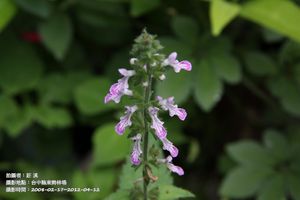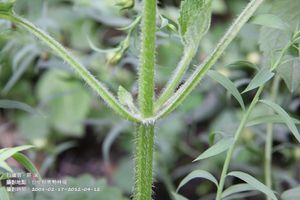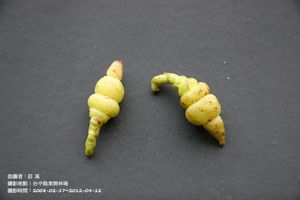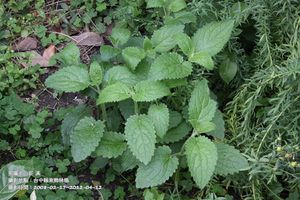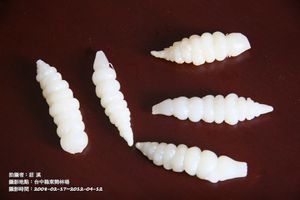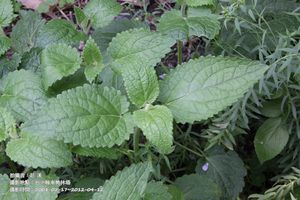草石蠶
出自台灣有毒中草藥毒性資料庫
| 中英文學名 | 科別 | 毒性 | 症狀 |
基本資料
|
科別 | 唇形科Labiatae |
|
屬名 | 草石蠶屬 Stachys |
|
中文學名 | 草石蠶 |
|
拉丁學名 | Stachys sieboldii Miq. |
|
英文名稱 | Chinese Artichoke,Artichoke Betony Chorogi,Japanese Artichoke |
|
中文俗名 | 地蠶(救荒)、甘露子、地露、甘露兒、土蛹、寶塔菜、地蟲草、地牯牛、蟲草、冬蟲草、土冬蟲草、白冬蟲草、肺癆草、土人參、地鈕、羅漢菜、旱螺螄(湖北鶴峰),益母膏(河北),米累累(河南盧氏),地母、地蕊(四川茂汶),地蠶、寶塔菜、螺螄菜(中國蔬菜栽培) |
植物圖片
|
草石蠶花 |
草石蠶葉序及莖 |
草石蠶塊莖(食用部位) | |
|
草石蠶 |
草石蠶塊莖 |
草石蠶葉序 |
草石蠶簡介
草石蠶外觀與冬蟲夏草相似,因此在使用上有時候會被誤用為冬蟲夏草,但草石蠶其實是一種植物,在台灣卻是被當作蔬菜來食用。在澎湖地區也有農民特地種植此種植物來販售。
外觀簡述
|
莖 | 宿根性草本,地下具多數匍匐枝,頂端具螺旋狀塊莖;莖直立,高 20~50 公分,莖方形四稜,被逆生長刺毛。 |
|
葉 | 葉對生,柄長 1~5 公分,葉片卵形或長卵形,長 3~10 公分,寬 1.5~6 公分,基部心臟形或近圓形,圓鋸齒緣,兩面被長柔毛。 |
|
花 | 苞片披針形,花序 3~6 輪,每輪花 3~6 朵,成塔狀穗形總狀花序,頂生枝端;小花梗基部有一對早落性剛毛狀小苞片;花萼鐘形,外被腺狀柔毛,5 齒裂;花冠淡紫紅色,冠筒內有毛圈,上唇直立而稍反捲,下唇平展 3 裂;雄蕊 4 枚,2 強,伸出花冠外;子房卵形,柱頭 2 裂。小堅果卵球形,黑色。花期 5~6 月,果期 6~7 月。花期 5~6 月。 |
|
果實 | 小堅果卵球形,徑約 0.15 公分,黑褐色,具小瘤。果期 6~7 月。 |
產地
中國大陸華北、西北地區。臺灣地區各地零星栽培供作疏食或藥用。
使用情況
1.食用:草石蠶的具多數地下匍匐枝,頂端具螺旋狀塊莖,可供食用。2.藥用:塊莖或全草:甘、平。效用:塊莖:袪風熱,利濕,活血散瘀。治黃疸,小便淋痛,風熱感冒,肺癆,虛勞咳嗽,小兒疳積,瘡毒腫痛,蛇蟲咬傷。
活性成份
|
莖[1-3] |
|
|
地上部分[4] |
|
活性研究
- 1. 抗腎絲球基底膜(anti-glomerular basement membrane, anti-GBM)腎炎,主要是由自身抗體對腎絲球基底膜的抗原產生不正常的結合作用而發生的疾病,而白血球在此種腎炎中扮演主要角色之一。實驗中口服給予患有anti-GBM的大鼠30 mg/kg acetoside,每天一次,連續15天,顯著的降低尿蛋白(urinary protein)。因腎炎聚集在腎絲球的白血球(包含CD4+, ED-1, CD8+, IL2 receptor+, Ia+細胞),在給予15天後,累積在腎絲球的數量都有明顯的下降[4]。血漿中的膽固醇(cholesterol)及肌肝酸(creatinine)亦有顯著的下降[5]。
- 2. 草石蠶中所含的aceteoside, stachysoside C, phenylethanoid glycoside,給予經氰化鉀(KCN)引起缺氧的小鼠,顯著的降低死亡小鼠的數目[3]。
毒性研究
- 症狀
- 未知
- 有毒成分[17-20]
- 1. Caffeic acid
- 2. Verbascoside
- 中毒劑量[6, 7]
- 未知
- 機轉
- 未知
- 基因毒性
- 以人類淋巴細胞為模型,給予verbascoside,濃度為0.01, 0.05, 0.1 mM,測量染色體畸變(chromosome aberrations, CA)及姐妹染色體交換(sister chromosome exchange, SCE)。結果顯示染色體畸變頻率(aberration frequency)及畸變細胞在0.01 mM以上均有顯著提高。姐妹染色體交換的數量也同樣在0.01 mM以上就顯著的升高。另外,在給藥48小時後,蛋白質PPAR-1及p53量也呈現濃度相關的顯著上升。以HPLC測量給藥後的細胞液發現,verbascoside水解為caffeic acid,而caffeic acid可能就是導致這些活性的物質[7]。
- 2. 針對草石蠶活性成分verbascoside及caffeic acid進行果蠅翅斑試驗(Drosophila wing spot test),研究結果指出verbascoside (27-173 mM)對並不會產生任何形態的翅斑,但caffeic acid (27-135 mM)確造成翅斑產生頻率顯著下降,而最高濃度(173 mM)則顯著上升。而在高活性(含cytochrome P450酵素)組別中,caffeic acid顯著的提高翅斑的產生頻率,顯示須經代謝後草石蠶活性成分才會較具基因毒性[6]。
毒性分級
參考文獻
1. Yin J, Yang G, Wang S, Chen Y. Purification and determination of stachyose in Chinese artichoke (Stachys Sieboldii Miq.) by high-performance liquid chromatography with evaporative light scattering detection. Talanta 2006; 70: 208-212.
2. Nishimura H, Sasaki H, Inagaki N et al. Nine phenethyl alcohol glycosides from Stachys sieboldii. Phytochemistry 1991; 30: 965-969.
3. Yamahara J, Kitani T, Kobayashi H, Kawahara Y. [Studies on Stachys sieboldii MIQ. II. Anti-anoxia action and the active constituents]. Yakugaku Zasshi 1990; 110: 932-935.
4. Hayashi K, Nagamatsu T, Ito M et al. Acteoside, a component of Stachys sieboldii MIQ, may be a promising antinephritic agent (2): Effect of acteoside on leukocyte accumulation in the glomeruli of nephritic rats. Jpn J Pharmacol 1994; 66: 47-52.
5. Hayashi K, Nagamatsu T, Ito M et al. Acetoside, a component of Stachys sieboldii MIQ, may be a promising antinephritic agent: effect of acteoside on crescentic-type anti-GBM nephritis in rats. Jpn J Pharmacol 1994; 65: 143-151.
6. Santos-Cruz LF, Avila-Acevedo JG, Ortega-Capitaine D et al. Verbascoside is not genotoxic in the ST and HB crosses of the Drosophila wing spot test, and its constituent, caffeic acid, decreases the spontaneous mutation rate in the ST cross. Food Chem Toxicol 2012; 50: 1082-1090.
7. Santoro A, Bianco G, Picerno P et al. Verminoside- and verbascoside-induced genotoxicity on human lymphocytes: involvement of PARP-1 and p53 proteins. Toxicol Lett 2008; 178: 71-76.
| 中英文學名 | 科別 | 毒性 | 症狀 |
